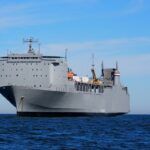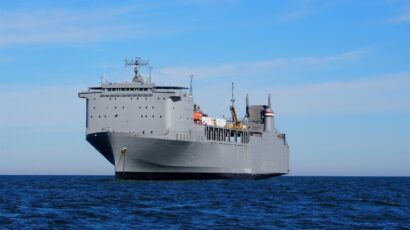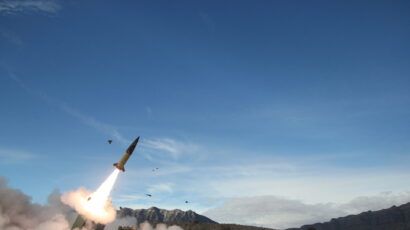Santa Kim is coming to town—with North Korean gifts that keep on giving
By Ankit Panda | December 13, 2019
 Illustration by Thomas Gaulkin (photo via KCNA; Hwasong-15 missile by Heribero Arribas Abato)
Illustration by Thomas Gaulkin (photo via KCNA; Hwasong-15 missile by Heribero Arribas Abato)
For a Marxist-Leninist monarchy with nothing close to a free press to speak of, North Korea is remarkably savvy at goading Western editors into crafting catchy headlines that ensure that the regime’s messaging makes it all the way from the Korean Central News Agency’s wires to page one of top American dailies. Its greatest hits include dusting off the obscure epithet “dotard” to describe President Trump in September 2017 and threatening to bracket Guam with four Hwasong-12 intermediate-range ballistic missiles in August 2017. More recently, a statement attributed to Ri Thae Song, a vice minister of foreign affairs in North Korea, said that it was “entirely up to the US what Christmas gift it will select to get” as December 2019 got underway.
You don’t have to be wrapped up in the holiday spirit to see why that’s evocative. In the days since, analysts and pundits have been debating what “Christmas gift” is likely. The December 7 test at the Sohae Satellite Launching Center is not it; it’s, as Jeffrey Lewis put it, a “lump of coal in [Trump’s] stocking,” but something big is likely coming. The “Christmas gift” message hearkens back to North Korea’s July 2017 inaugural launch of an intercontinental-range ballistic missile (ICBM), after which Kim directed his missile scientists to “frequently send big and small ‘gift packages’ to the Yankees.”
Kim’s missile scientists were largely muzzled between November 2017 and May 2019; as in the past, North Korea held off from missile launches while talks with the United States were on. Since May 4, however, when the testing campaign re-started, North Korea has launched 25 or 26 missiles—mostly short-range, with the exception of one submarine-launched ballistic missile. All of the missiles tested this year have employed solid propellants, meaning that they are more flexible and responsive. (Solid propellant missiles are fueled as they are manufactured, unlike liquid propellant missiles, which must be filled with fuel and oxidizer just prior to launch). In a crisis, solid propellant missiles are more likely to survive attempts at preemption because they’re more mobile and easier to operate. Beyond using solid propellant, at least one of Kim’s newly tested missiles this year has exhibited quasi-ballistic flight trajectories, which could present a challenge to existing missile defense interceptors deployed on the Korean Peninsula.
Naughty or nice? If there is a “Christmas gift” that awaits the United States, it is unlikely to be something as pedestrian as a short-range ballistic missile. Instead, Kim is likely gearing up for one of three possibilities: a second launch of the Hwasong-15 ICBM (the same one launched once in November 2017); the inaugural flight-test of a solid propellant ICBM or intermediate-range ballistic missile; or the inaugural launch of a new-generation of space launch vehicle.
The “very important” test that was carried out on December 7 at the Sohae Satellite Launching Ground’s static liquid propellant engine test stand would suggest that Kim’s scientists have just tested a large liquid propellant engine; that is a reliable short- to medium-term indicator of new launch activity. In March 2017, at Sohae, Kim oversaw the first-ever test of the RD-250-variant engine that would weeks later see (unsuccessful) testing under the Hwasong-12 intermediate-range ballistic missile. In late-June 2017, Kim similarly oversaw the testing of the upper-stage engine of the Hwasong-14, which was launched just weeks later.
There is reason to expect that whatever North Korea does will include something qualitatively new. For instance, if Kim does order a second test of the Hwasong-15 ICBM, we may expect to see a new type of indigenously built heavy launch vehicle. That would be a notable development, as it would indicate that North Korea had managed to successfully wean itself off its reliance on the six-odd heavy logging trucks that it had imported under false pretext from China and converted for use as transporter-erector-launchers. Separately, Kim may choose to use a new launch to overfly Japan into the northern Pacific with an ICBM—something North Korea has never done before. A recent statement hinting that Japanese Prime Minister Shinzo Abe should expect to see a ballistic missile suggests that whatever may be coming is likely to either splash down in the waters around Japan or overfly the country. Kim may also choose to demonstrate a multiple reentry vehicle capability off the Hwasong-15.
Perhaps the most interesting option for North Korea, however, would be a space launch. Unlike missile tests, which are revealed to the world only when they happen, North Korea insists that its space activities are entirely civilian in nature and peaceful. In the past, this has meant that it goes to pains to behave like a “normal” country, issuing warnings to respectable international organizations like the International Maritime Organization indicating hazard zones for spent rocket stages falling back to earth. There hasn’t been a satellite launch in North Korea since February 2016 and, in late-2017 and early-2018, there were strong signs that Pyongyang was hard at work at a successor generation of space launch vehicles to the Unha-3, which launched the Kwangmyongsong-4 satellite in 2016. North Korean space program officials have indicated interest in geosynchronous orbit payloads and earth-observation satellites. None of North Korea’s previous orbital payloads are known to have performed useful remote sensing work; that may be about to change.
In the present political context, the advantage of a space launch would be for North Korea to engineer a crisis with the Trump administration. The administration—at least with Iran—has made clear that, from their view, space launch vehicles and ICBMs are birds of a feather (even though, in practice, this relationship is overstated and largely misunderstood). Could Trump overlook an announced space launch by North Korea—or would he seek to rush to the negotiating table to prevent that from happening as he approaches an election? Pyongyang may be betting on the latter, hoping to pull off a “reverse Leap Day Deal,” where a space launch announcement salvages diplomacy with the United States rather than scuttling it.
But that’s just the “Christmas gift.” Exhausting the possible range of other “gifts” that might lie ahead into 2020 is less simple. After the December 7 test, Kim Yong Chol, formerly Secretary of State Mike Pompeo’s negotiating counterpart, released a statement in which he underscored that North Korea’s objective was to “surprise” President Trump. That’s not a particularly comforting assertion, as North Korea potentially has plenty of surprises up its sleeve. Two of its threats from 2017—to bracket the waters around Guam with ballistic missiles and to conduct an atmospheric nuclear test—were never formally taken off the table. Recently, too, North Korea demonstrated that it has a new ballistic missile submarine under construction.
Over the course of 2020, North Korea could also look to conduct a test of its new Pukguksong-3 submarine-launched ballistic missile off of either that submarine or its older Gorae-class submarine. Separately, analysts have noticed intriguing activity at the ever-mysterious experimental light water reactor at the Yongbyon nuclear complex. Could a formal start-up of that reactor lie ahead? During his 2019 New Year’s Day address, Kim did spend considerable time discussing domestic sources of electricity, including “atomic power.” Any or all of these “surprises” may lie ahead. In his statement, Kim Yong Chol indicated that North Korea was returning to its old risk-acceptant ways, underscoring that Pyongyang had “nothing to lose.”
In short, Kim has a long list of options to choose from—and he’s probably checking it twice before he makes his mind up. In fact, an official statement from Pyongyang released Thursday notes that the United States’ decision to call a new session of the United Nations Security Council to discuss North Korean missile launches “helped us make a definite decision on what way to choose,” suggesting that Kim had been keeping his options open.
Kim and the US election. President Trump’s recent reaction to North Korea’s test at Sohae contained a curious assertion: Kim “does not want to void his special relationship with the President of the United States or interfere with the US Presidential Election in November.” Trump has famously been unwilling to acknowledge the well-substantiated Russian state-backed effort to interfere in the 2016 election, so it is curious that North Korea—a country that has not publicly, credibly been accused of election interference—came under his microscope. Could the president have an unpublicized deal with Kim to hold off on missile and nuclear testing through the 2020 US elections? Publicly available evidence would suggest no, but complete accounts of the president’s discussions with Kim Jong Un are not readily available.
The president, after Singapore, made a habit of emphasizing that his diplomacy had gotten North Korea to stop launching ballistic missiles and conducting nuclear tests. In April 2018, Kim Jong Un, at the fourth plenum of the 7th Central Committee of the Workers’ Party of Korea, announced a unilateral moratorium on ICBM and nuclear tests—with the reasoning that North Korea‘s development efforts through 2017 were so robust that no further testing was required. Trump still used the moratorium to great effect, convincing many of his supporters that his bold and personal diplomacy with Kim had gotten results that no American leaders had gotten in the past. (Kim’s father agreed to a long-range missile testing moratorium in 1999 that lasted through July 2006.)
Kim Jong Un, however, does have leverage to engineer a crisis at an inopportune time. With an election less than eleven months away, Trump has reason to stay Kim’s hand from signing any ICBM test orders, lest the fiction of the “Singapore process” erode completely in the eyes of the American public. But, as 2017 showed, North Korea’s search for leverage in the form of qualitatively advancing its nuclear forces can push decision-makers in Washington toward dangerous ends. Where Trump’s instincts during the diplomatic process with Kim were to express his feelings through heartfelt letters, hand-written and delivered to Kim’s desk, the president may find himself once again drawn to expressing himself through “fire and fury,” sparking a new crisis.
Together, we make the world safer.
The Bulletin elevates expert voices above the noise. But as an independent nonprofit organization, our operations depend on the support of readers like you. Help us continue to deliver quality journalism that holds leaders accountable. Your support of our work at any level is important. In return, we promise our coverage will be understandable, influential, vigilant, solution-oriented, and fair-minded. Together we can make a difference.
Keywords: 2020 election, ICBM, Kim Jong-un, North Korea, space launch vehicle
Topics: Analysis, Nuclear Risk















